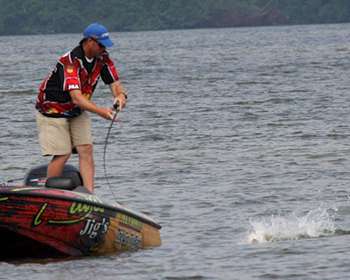
The lakes that Alabama pro Greg Vinson fishes near home and on the Elite Series trail typically span tens of thousands of acres, more than he could hope to cover. Fortunately, Vinson can focus his efforts on just a small key zone: the tailrace.
In his search for current that positions fish, Vinson often runs his boat up to the very upstream tip of a reservoir and parks just downstream of the dam. It's not a year-round pattern or location, but more often than not the qualities that define bass location — current and food — are present, so, except when fish are in the midst of spawning, it's a must-see place on his pre-tournament checklist.
"Probably the most productive time to fish a tailrace is when oxygen levels on the lake are at their lowest," he says. "That typically occurs on Southeastern reservoirs in the summertime. The oxygen content will start dropping in deeper water usually around late May into June." At that time, the fish go on the hunt for cooler water and elevated oxygen levels.
"The great thing about a tailrace is that it offers both," Vinson explains. "Tailrace water actually comes out of the lower end of the lake above the dam. So that cooler water coming out is not very well oxygenated because of where it came from in the water column, but when it blows through those turbines, they act like giant aerators. So what you have is one big comfort zone, an area with cool water and plenty of oxygen."
This may attract largemouth, but it's an absolute magnet for smallmouth and their spotted bass cousins as a consequence of the resulting heavy current. "Especially for a spotted bass, it doesn't get any better than that in the summertime," he says. "They have everything they need right there. The shad migrate and get right up against the dam."
But it's not just a matter of heading to the dam, throwing out an anchor and filling the livewell. Certain subtle areas produce more consistently. Miss out on them and sometimes you'd swear there wasn't a bass anywhere nearby. "When I'm fishing one of those areas, I know the fish are going to be there, so I pick the smaller areas where I feel like schools are going to hang out, ambushing shad," Vinson says. "It's just like fishing a river system where you're looking for eddies in the current. Some of them are real visible — where the water will break off of a shallow rockpile, for example. It'll form a seam and the fish will use that seam to ambush shad that are being washed around in the current."
While his electronics provide "eyes" beneath the surface, Vinson also takes clues from how the top of the water column acts right in front of him. "The other thing you can look for is a boil under the water," he says. "When you see water boiling up out in the center, that's created by a rockpile upstream of the boil. If you throw your bait right at the boil you're actually throwing behind the cover, so you want to throw upstream. If you can find that situation in strong current, usually your biggest fish are going to be where the primary current is. The smaller fish get pushed away by the bigger fish and they'll usually be in the secondary eddies where the current is not as strong."
And once you find the sweet spots, it's possible to load the boat in a hurry. Energized by the current and the oxygen, the fish will school up and feed whenever the generation schedule dictates. Vinson's first choice of lure is often a lightly-weighted NetBait Super Twitch soft jerkbait. He tends to fish it fast because that generates a reaction bite on bass keyed in on "shad that are being pushed by the current," he says. "These fish are surface oriented," he adds.
Accordingly, the purpose of the weighted hook is to prevent the lure from skipping out of the water. He also uses a big X-Wire Spinnerbait, up to 1 1/2 ounces in weight, and slow rolls it through the rockpiles. "When the water's cooler, that's a real strong option for those big spots," he says. He also usually has a crankbait rod on the deck.
Depending on the depth of the tailrace, he typically ties on a diving plug that'll get down to somewhere between 4 and 12 feet deep. Regardless of what category of lure he chooses, he makes a concerted effort to "match the hatch." Natural colors are necessary because the water coming out of the dam is usually clearer than in much of the rest of the lake.





